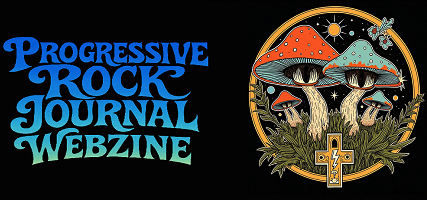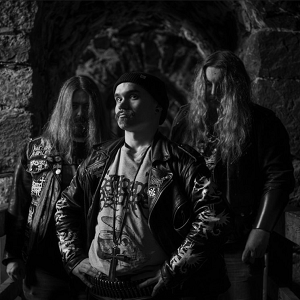Forged in the primordial flames of Doom Metal, Temple of Salem emerge from the shadows with their debut EP “Of Witches and Finders” (released July 3, 2025). With an aura of ancient rites, cursed jamming sessions, and a vision where melody intertwines with madness, the Finnish trio deliver an offering that is both majestic and mournful. We
had the pleasure to speak with the band about their origins, their creative process, and
their vision of eternal Doom.
“Greetings from our depths of doom! This is Volburg the Conqueror, your Finnish doom commander speaking.“
To begin, could you introduce Temple of Salem to our readers? How did the band come together, and what inspired the project’s birth?
Temple of Salem is NOW a four piece BAND that wants to send the prophecy of doom through the whole world. Our band came along as the three of us (Volburg, Silversword and Ron) were listening to some records and thought that there is not enough new doom metal in Finland these days. And as I’m talking about doom metal I mean the oldschool stuff, not that stoner doom. As I am vastly inspired by the time I spent with Smoulder, all three of us are heavily inspired by classic doom metal bands, such as Candlemass, Cathedral and Reverend Bizarre. Count Silversword also had performed Black Sabbath songs with numerous cover bands back in the days, so I knew he had a lot to give for this genre.
Your Bandcamp description speaks of primordial days and dark rites of jamming. Could you tell us more about these early sessions and how they shaped “Of Witches and Finders”?
All three of these songs started as rehearsal place jams. Ron or me would come up with a riff idea and then we just started experimenting about what direction the riffs are taking us. We wanted to keep it raw and impulsive in that kind of a way.
Most of the vocal arrangements were written by Count Silversword. I might have given him some small bits of melodies to work with but I always give him free space to experiment himself. I can’t write something that he can work with immediately and I also want him to sound like himself.
Each member carries a distinctive title – Count Silversword, Ron the Bearer of Orkrist, Volburg the Conqueror. How do these alter egos connect to your music and identity as a Band?
Temple of Salem is not only about doom metal but our own kind of world. A world where the witches fled with fear and anger. Every alter ego is an occupant of this damned world and we are looking forward to giving our listeners more glimpses of what it is all about.
Could you guide us through the recording process? From the catacombs of Konala to Roihupelto Legends Studios, how did these environments influence the sound?
We had zero budget so that was the most reliable way of making up the EP with our own terms. We wanted the guitar to sound raw and heavy and also we wanted it to sound raw all in general. Not too polished because that’s what kills my interest in many bands nowadays if the sounds are too polished and clean. Especially when you’re making music like this. We are still very happy with the guitarsound we were able to achieve at Roihupelto Legends Studios and will probably continue working there with our upcoming titles.
Sonically, the record balances heaviness and melody. How do you approach songwriting to keep this equilibrium between majestic and mournful?
That’s something I personally have always liked about making music and as we write our stuff as a band. Ron the Bearer of Orkrist always comes up with the heaviest riffs as me and Count Silversword are able to write some really cool melodies. We are unintentionally aiming to have those memorable riffs and mournful melodies together and I think that Finnish music in general has that tone and it has shaped our minds as a songwriter forever since.
Doom Metal has a long and diverse tradition. Which bands, eras, or scenes have had the greatest impact on your style?
It’s always hard to answer these kinds of questions shortly but let’s try it out. Candlemass and Reverend Bizarre is probably something we can ALL stand along to. Then it probably diversifies between bandmembers a little. For example, I have a big influence coming from the 70s hard rock bands such as Deep Purple, Uriah Heep and early Pentagram material. Also Black Sabbath.
The cover art comes from Torsten Wasastjerna (1897). Why did you choose such a historical and symbolic artwork, and how does it resonate with the music?
We were trying to figure out what we should do with the cover and Count Silversword came up with this idea. He thought that bands as Bathory and Candlemass have always used well known paintings, why shouldn’t we? Then he showed me this painting and it instantly hit me. This is the one we’re using.
From mixing to mastering, you worked with Samuel Immonen and Collin Jordan. How important was their contribution in shaping the final result?
Samuel did an amazing job as always. I’ve known him for a long time and seen him developing his mixing skills since 2015 or something around that. It was a clear choice. Collin Jordan also gave this record a magnificent final touch and I think that the outcome is great.
How does Temple of Salem see itself within the contemporary Doom scene? Do you feel more connected to the classic lineage, or to the modern and experimental side of the Genre?
I personally feel more connected to the classic lineage as we are not inventing the wheel again but at the same time I feel like we aren’t bowing to anyone as well. Yes, we do have our influences and we make it pretty clear but we are not trying to sound like something that has already been done.
Finland has a rich underground and Metal tradition. How has the local scene supported or influenced your path so far?
The attendance to our first show ever was great! We weren’t expecting much because I feel like Finland doesn’t really have a doom metal scene. We have some really good doom metal bands but everything evolves around the small underground heavy metal scene.
In your view, what role does atmosphere play in Doom Metal, compared to sheer Heaviness?
Sheer Heaviness has a greater impact when you put it up against some mournful atmosphere. Having both of these is a way of making things more interesting.
The EP marks your first official release. What did you learn from this process that you will bring into future works?
We will continue experimenting with our new songs mostly at the rehearsal place. We want to keep this project as natural as it can get. Then before hitting the studio we clean it up and give some finishing touches and make it even better. We have already started demoing some new material.
Looking ahead, what are the next steps for Temple of Salem? Can we expect live rituals, tours, or new recordings in the near future?
Live rituals and new recordings are ahead. We wish to take this project on the road some day but there is still a lot of work to do before that.
Finally, what message or feeling would you like “Of Witches and Finders” to leave with the listener?
As you step towards the squeaking gates of a Temple, beware. There is something wicked lurking in the shadows that might awake the fallen guardians of eternal doom.
We thank Temple of Salem for opening the gates of their dark temple and sharing insights into their music and vision. With “Of Witches and Finders,” the band marks only the beginning of a journey where Doom is eternal, and we look forward to following their path into the shadows.
Purchase “Of Witches And Finders” on Bandcamp: https://templeofsalem.bandcamp.com/album/of-witches-and-finders

